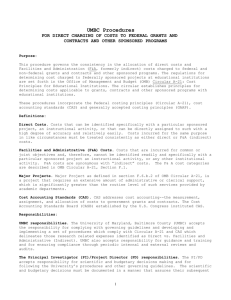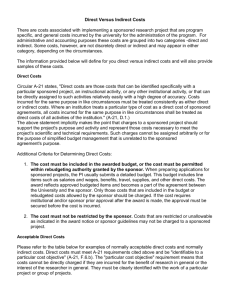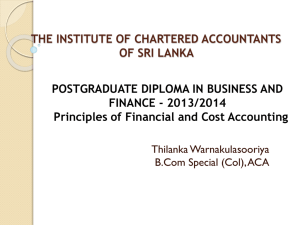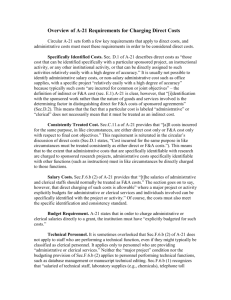USM Office Procedures for Direct Charging
advertisement
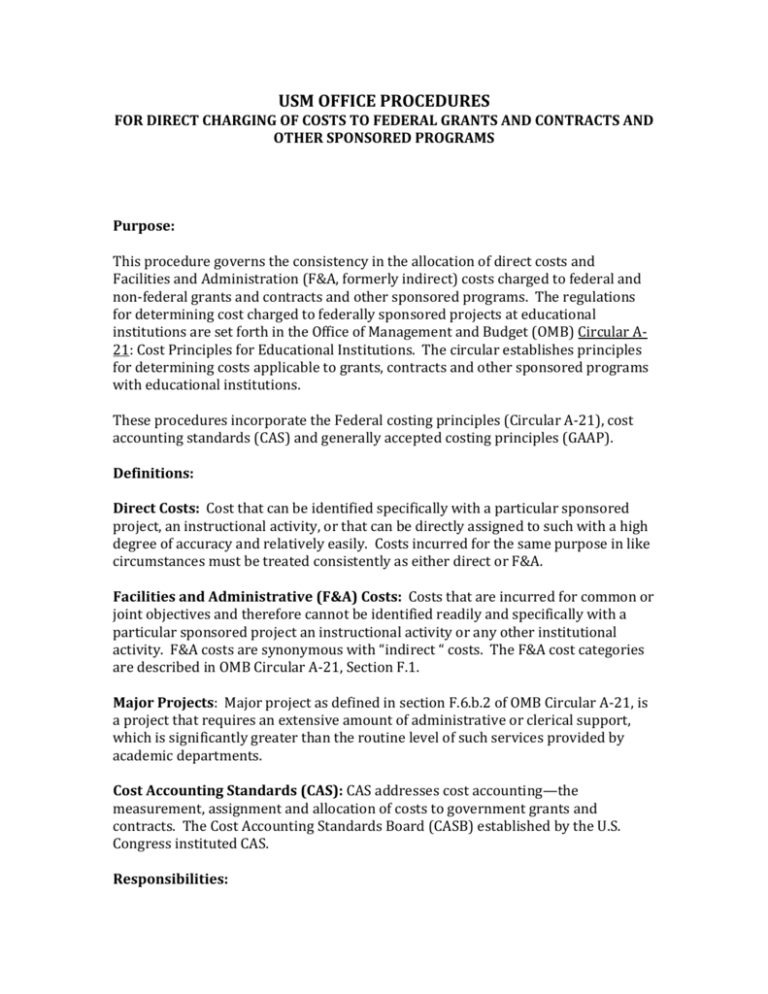
USM OFFICE PROCEDURES FOR DIRECT CHARGING OF COSTS TO FEDERAL GRANTS AND CONTRACTS AND OTHER SPONSORED PROGRAMS Purpose: This procedure governs the consistency in the allocation of direct costs and Facilities and Administration (F&A, formerly indirect) costs charged to federal and non-federal grants and contracts and other sponsored programs. The regulations for determining cost charged to federally sponsored projects at educational institutions are set forth in the Office of Management and Budget (OMB) Circular A21: Cost Principles for Educational Institutions. The circular establishes principles for determining costs applicable to grants, contracts and other sponsored programs with educational institutions. These procedures incorporate the Federal costing principles (Circular A-21), cost accounting standards (CAS) and generally accepted costing principles (GAAP). Definitions: Direct Costs: Cost that can be identified specifically with a particular sponsored project, an instructional activity, or that can be directly assigned to such with a high degree of accuracy and relatively easily. Costs incurred for the same purpose in like circumstances must be treated consistently as either direct or F&A. Facilities and Administrative (F&A) Costs: Costs that are incurred for common or joint objectives and therefore cannot be identified readily and specifically with a particular sponsored project an instructional activity or any other institutional activity. F&A costs are synonymous with “indirect “ costs. The F&A cost categories are described in OMB Circular A-21, Section F.1. Major Projects: Major project as defined in section F.6.b.2 of OMB Circular A-21, is a project that requires an extensive amount of administrative or clerical support, which is significantly greater than the routine level of such services provided by academic departments. Cost Accounting Standards (CAS): CAS addresses cost accounting—the measurement, assignment and allocation of costs to government grants and contracts. The Cost Accounting Standards Board (CASB) established by the U.S. Congress instituted CAS. Responsibilities: USM Office responsibilities: USM office accepts the responsibility of complying with governing guidelines and developing and implementing a set of procedures which comply with Circular A-21 and CAS which delineates those research related expenses identified as Direct vs. Facilities and Administrative (Indirect). The Principal Investigator (PI)/ Project Director (PD) responsibilities: The PI/PD accepts responsibility for scientific and budgetary decisions making and for following the USM procedures and other governing guidelines. The scientific and budgetary decisions must be documented in a manner that assures their subsequent accurate implementation and permits auditing by internal and external sources. The PI/PD, along with Project Managers and Grant Accountant also accept the responsibility for following the procedures of USM and for ensuring the appropriateness of all charges to a sponsored program. I. Procedure The procedure will apply to all major categories of cost under each major function or activity such as instruction, organized research, other sponsored activities and other institutional activities as defined in section B, Circular A21. The criteria for determining when costs incurred for the same purpose in like circumstances are treated either as a direct cost only or as an indirect cost only with respect to final cost objectives are described below. Particular emphasis should be placed on items of cost that may be treated as either direct or indirect costs (e.g., supplies, materials, salaries and wages, fringe benefits, etc.) depending upon the purpose of the activity involved. The USM office follows Circular A-21 in determining the treatment of costs as direct or indirect. Circular A-21 defines Direct cost as cost that can be identified specifically with a particular sponsored project, instructional activity or other institutional activity, or can be directly assigned to such activities relatively easily with a high degree of accuracy. Conversely, costs incurred for common or joint objectives, which cannot be identified readily and specifically with a particular sponsored project, instructional activity or other institutional activity are treated as indirect costs. USM’s indirect costs are consistent with the definitions of specific indirect cost categories in section F of Circular A-21 (identification and assignment of facilities and administration cost). USM also follows the guidelines of Section F.6.b of Circular A-21, which specify the normal treatment of certain costs commonly incurred by academic departments and organized research units. It is the responsibility of the Grant Accountant to classify costs incurred for the same purpose, in like circumstances, consistently as either direct or indirect costs. This concept is reinforced and emphasized in Cost Accounting Standard (CAS) 502, “Consistency in Allocating Cost Incurred for the Same Purpose.” This standard, which USM is required to follow, states that cost incurred for the same purpose and in like circumstances are either direct or indirect. Complying with this standard guards against overcharging and helps prevent double counting. When administrative and clerical costs are directly charged to the sponsored agreements, it is because the activity explicitly budgets for administrative or clerical services and the individuals involved can be specifically identified with a Major Project. II. Cost Categories Normal Direct Costs: 1. Salaries, Wages and Fringe Benefits a. Faculty b. Professional staff (e.g. research associates or scientist) c. Postdoctoral fellows d. Technicians e. Lab assistants f. Students performing scientific or technical work 2. Materials and supplies a. Chemicals b. Glassware c. Compressed gases and liquids d. Computer software 3. Other direct costs a) Travel b) Consulting services c) Equipment d) Long distant telephone charges e) Sub-awards Normal F&A or Indirect Costs: 1) 2) 3) 4) 5) 6) Administrative and clerical salaries and associated fringe benefits Office supplies Postage Local telephone services Memberships Subscriptions A. Secretarial, Clerical and Administrative Salaries and Wages The salaries of administrative and clerical staff should normally be treated as (F&A) indirect cost. The direct charging of these costs may be appropriate where the nature of the work performed under a particular major project requires an extensive amount of administrative or clerical support, which is significantly greater than the routine level of such service provided by academic departments. The costs need to be identified specifically with a particular sponsored project relatively easily with a high degree of accuracy as stated in section F.6.b2 of Circular A-21. Concerning Circular A-21, section F.6.b, exhibits C; the following examples of “major project” are illustrative of circumstances where direct charging of salaries for administrative or clerical staff may be appropriate. 1) Large, complex programs, such as General Clinical Research Centers, Primate Centers, Program Projects, environmental research centers, engineering research centers. A group of awards considered to be related, where the technical work plans is (Superconductivity Research). Any center established by the Federal Government through a center grant and other grants and contracts that entail assembling and managing teams of investigators. 2) Clerical or administrative personnel hired specifically for a project, whose position terminates with the project termination. 3) Projects that involve extensive data accumulation, analysis and entry, surveying tabulation, cataloging, literature searching and reporting. 4) Projects that require making travel and meeting arrangements for large numbers of participants, such as conferences and seminars. 5) Projects in which the principal focus is the preparation and production of manuals and large reports, books and monographs (excluding routine progress and technical reports). 6) Projects that are geographically inaccessible to normal departmental administrative services, such as seagoing research vessels, radio astronomy projects, and other research field sites that are remote from the campus. Project s with major overseas components would fall into this category. 7) Individual projects requiring project-specific database management; individualized graphics or manuscript preparation; human or animal protocols; and multiple projectrelated investigator coordination and communication. These situations are considered “unlike circumstances” under CAS 502. These examples are not exhaustive nor are they intended to imply that direct charging of administrative or clerical salaries would always be appropriate for the situations illustrated in the examples. Note, this section of the policy deals with salaries and wage of secretarial, clerical and administrative personnel and does not apply to salaries and wages of specialist and technical staff. B. Technical Staff Salaries and Wages The salaries and wages of specialist and technical staff such as programmers, technicians, editors, graphic designers, animal maintenance staff, photographers and others whose salaries and wages are normally treated as direct costs. C. Research Materials, Research Supplies and Research Equipment The costs of research materials, supplies and equipment, e.g., chemicals, glassware, research record keeping and reporting materials and supplies, etc.), instructional supplies, animals, animal care and other specialized services, travel, consulting services, patient care, long distance telephone toll charges identifiable to research, instruction or other direct cost objectives be treated as direct costs. D. Repair and Maintenance Repairs and maintenance involving internal building operations and equipment which are identifiable to research projects, instructional activities or other direct cost objectives are treated as direct costs based on a work order system or invoices from vendors. The direct charges are credited against the Operations and Maintenance indirect cost pool. Rent and other associated costs of facilities used to conduct off-campus sponsored projects are also treated as direct costs. E. Other Costs The costs of office supplies, postage, local telephone, memberships, general copying, fax and similar costs are treated as indirect costs; except under conditions which USM considers “unlike circumstances” under CAS 502. Examples of special circumstances that may justify direct charging of these cost include: 1) Office supplies and postage-special circumstances may exist if a project has a special or unique need for such supplies and postage that clearly differs from the normal use of these items by other activities of the institution. The use of supplies or postage must be significantly greater than the routine level of such items provided by academic departments and must be used specifically for the technical purposes of the project rather than to support administrative or clerical efforts. Examples of these circumstances may include a project that requires significant data collection through and extensive mail survey or project providing notebooks to a large number of workshop participants. 2) Telephone-special circumstances may exist where a separate dedicated line is necessary solely for the performance of the project (i.e. a telephone hot line or survey). 3) Memberships-special circumstances may exist if a project requires a subscription to a professional journal and a membership is required to obtain the subscription. 1 1 Effective January 14, 2014
